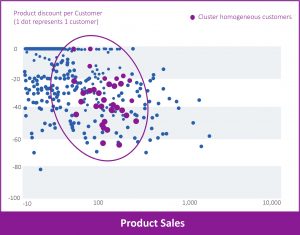How Big Data Is Transforming Marketing in 4 Ways

Futurism Technologies
January 28, 2019 - 5.9K
5 Min Read
Since the inception of the Internet almost 2 decades ago, big data technologies & nbsp; have rapidly emerged as the biggest catalyst for marketers. At its core is the proven ability of big data to analyze the torrents of terabytes about everything from customer behaviors to preferences and convert it into the practical and actionable data points. It’s not a coincidence that McKinsey has described big data as the “pivot-point moment for marketing and sales” and has predicted that retailers can increase their operating margins by more than 60 percent and that the US healthcare sector could reduce costs by 8 percent through data-analytics efficiency and quality improvements.
However, with each passing day and technical advancement in the big data technologies, data analytics will become more and more inseparable from the overall marketing schema of companies. With its unique insights and ability to view customers as individuals rather than merely a selling opportunity, it will reshape the sales and marketing activities in never-seen ways. This article is an attempt to pinpoint precisely the modus operandi of that unavoidable and soon-to-arrive reshaping.
1. Pricing Strategy:
The fact that a nominal 1% price increase can result in an 8.7% rise in operating profits explains the dire significance of pricing. But despite this well-established and symbiotic relationship between pricing and profit, 30% of the pricing decisions of companies fail to reach the best price. Consequently, it negatively hampers the revenue.
Big data technologies can emerge as a silver bullet here, as it can rationalize large piles of existing or potential customers’ buying habits to identify their overall willingness to pay, certain customer demographics which can pay more if products or services are slightly altered. Moreover, modern big data technologies can help companies in carving up new opportunities for differentiated pricing for a single product. Eventually, with big data, the whole pricing process will go through 3 stages:
1. Retroactive analysis of consumer’s past purchase history, behavior, and choices.
2. Statistical scrutiny to decide the price elasticity of demand by uniting the purchase data and market dynamics.
3. Business optimization by examining the costs acquired in manufacturing and identifying the price point with maximizing profits.

2. Budget Allocation:
Amidst the mushrooming of various marketing channels to reach out to consumers, it’s not easy to gauge the effectiveness of every channel in ensuring higher ROI. Different channels have different strengths and they serve different purposes. To achieve a higher economy of scale, thus, it becomes vitally important for businesses to allocate optimum budget to right platforms.
Through market mix modeling techniques of big data, marketers can address this perennial problem quantitatively and qualitatively. Since it enables companies with predictive insights about the profitability of campaigns even before execution, they can proactively zero in on the exact channels that can surely fire up the revenue funnel. Clearly, it opens up the whole new vista of possible marketing activities and their predictable future impact on ROI, profits, and sales.
3. Contextualized Marketing:
Even a cursory glance at most of the marketing platform stacks of companies will reveal that they aren’t integrated at the data and process levels. It majorly has stemmed from the fact that modern marketing channels are changing at a galloping speed. The legacy and yesterday’s marketing platform stacks fail the compatibility test with this ever-evolving channels. This apparent incongruence is causing a chasm between data and process which leaves companies without strong contextual marketing. Even though contextual marketing hasn’t received the same level of attention as search PPC, organic search marketing, social media and other types of traffic, it is exceedingly effective. Note that over 80% of all Internet users engage with Google Display Ads.

Data analytics, with its dynamic big data technologies, can help companies in sharpening up the targeting- the soul of every contextual marketing. Regardless of whether you are using top down or bottom up targeting strategy, big data can help you to scrap the list of websites where you are not getting enough response. You can blacklist domains that are unsuitable to your marketing communication. Similarly, you can also scrap content that is dynamically generated. These techniques are highly effective in discarding irrelevant websites from your contextual campaigns’ ecosystem – especially if you are targeting foreign countries.
4. Go-To-Market Plans:
As a subset of a marketing plan, go-to-market plan chalks out a specific growth strategy. It comes into existence when a company is eying market expansion, selling new products (services), or do both. It’s an arduous process comprising of data gathering and analysis, market and client identification, competitive analysis, sales and support model, product roadmap etc. Clearly, along with time, it costs money too. It’s then hardly a surprise that biopharma companies normally spend 20% to 30% of their revenues on selling, general, and administrative. If they can align go-to-market strategies with regions and territories that are teeming with higher sales possibilities, the go-to-market cost can be reduced drastically.
Big data can exert a mighty impact in creating less-expensive go-to-market plans through following procedures-
Stage 1: A proper synthesis of the market, customer data, and the existing sales force
Stage 2: Through big data optimization, companies can perform modeling of market size and sales force workload
Stage 3: In order to estimate the territory balance, diagnosis mechanism will be performed
Stage 4: Based on the diagnosis, possibilities for newer realignment of the sales process including reallocation of a new sales force, adding or removing existing sales force will be explored Key

- Since big data technologies are adding business value to cold customer insights, they are going to become the most potent weapon for marketers.
- Through a thorough analysis of buying behavior, purchase patterns of various demographics and willingness of buyers to spend more, big data technology can help businesses to finalize on the best price for their products.
- By sharpening the focus on targeted customers, big data can become a pivot in contextual marketing.
- Via data optimization and territory balance optimization, big data technologies can be helpful in reducing go-to-market cost.
Subscribe Now!
TRENDING POSTS
-
The Role of Smart Maritime IoT Solutions in Enhancing Maritime Safety
-
Data Integration Unlocked: From Silos to Strategy for Competitive Success
-
Navigating the Shadows: Understanding Zero-Click Attacks in the Digital Age
-
AI Reimagined: Crafting Next-Gen AI Apps with Expert Fine-Tuning
-
Explore Next-Gen Digital Solutions with Futurism at MWC 2024
-
Futurism Unleashes the Technology of Tomorrow at MWC Barcelona 2024
-
Futurism AI: Turning Ideas into Apps at Lightning-Fast Speed
-
Accelerate AI Across Your Enterprise With Futurism AI
-
Futurism to Address the Biggest Security Challenges at RSS 2022
-
Futurism at SelectUSA 2022: Steering the Next Wave of Businesses
-
Futurism to Uplift the MSP Business Community at the MSP Expo 2022
-
Futurism Sets Out to Address the Biggest Security Challenges at the RSA Conference 2022
-
5 Ways to Prepare Your Business for Digital Transformation
-
4 Ways To Win at Digital Transformation on a Shoestring Budget
-
Futurism: Empowering MSPs at the Channel Partners Conference & Expo 2022
-
Why AI in Digital Marketing is the Next Big Thing?
-
Futurism brings ‘Mobile First Digital Transformation’ to the fore at MWC Barcelona 2022
-
Cybersecurity for Rural Hospitals: How can Rural Hospitals become Cyber Smart?
-
Futurism Empowers Rural Health Care Community at the AHA Rural Health Care Leadership Conference
-
The Biggest Problem With Cybersecurity In Healthcare Sector, And How IBM QRadar Can Fix It?
-
How IBM MaaS360 is Revolutionizing Endpoint Security in the Healthcare Industry?
-
Futurism to Present its MSP Partner Program at the Channel Partners Conference & Expo 2021
-
EndPoint Security in Healthcare Matters and IBM MaaS360 Can Help
-
How AI Will Enable Faster Adaptation of Digital Transformation
-
How Is Digital Modernization Important In Supplier On-Boarding?
-
Top 10 Email Marketing Tips for This Holiday Season
-
Benefits of using ERP Software for Energy and Gas Industries


